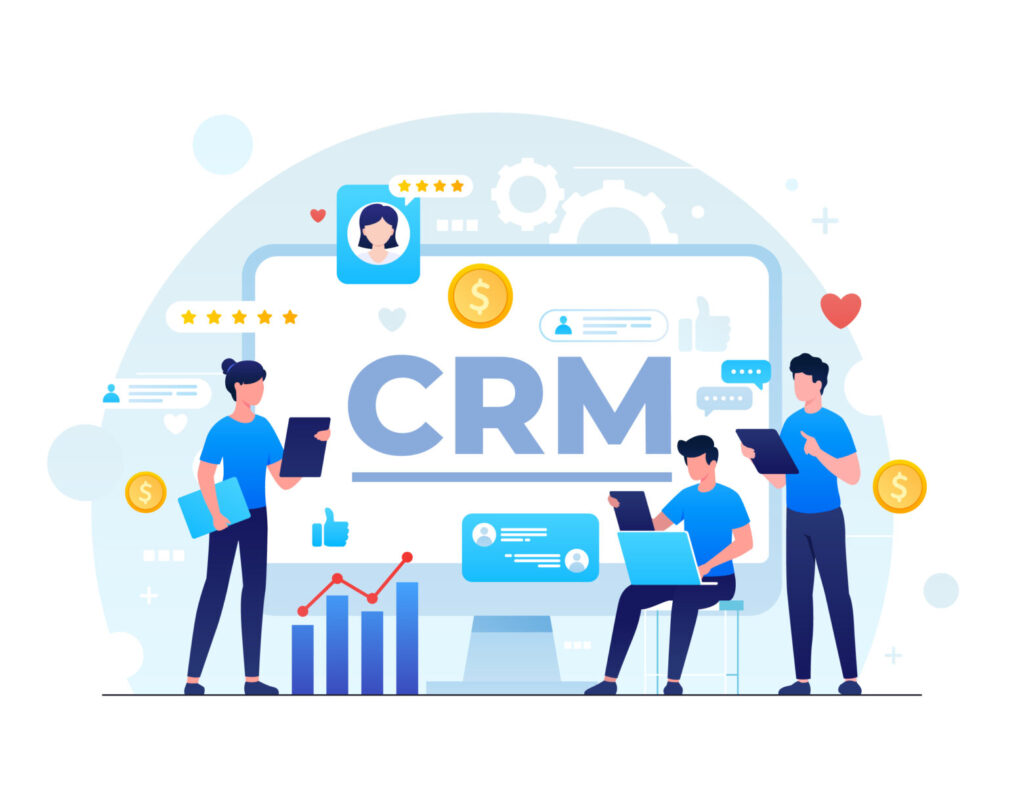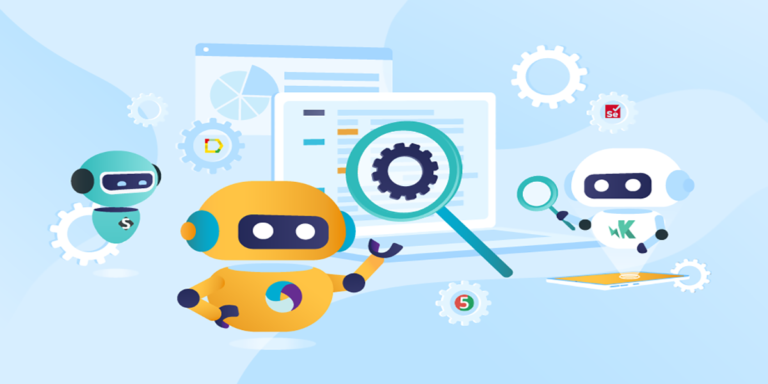Table of Contents
How to achieve more results? How do I improve the business processes in my company? We bet you ask yourself these questions. And the answer exists.
In the modern world, when everything moves so fast, the automatization of business processes is a must. Multitasking, the huge flow of information and the race for the best result take us to the place where we realize the need to implement the systematization of business.
Modern technologies offer solutions such as CRM, ECM, and ERP systems that help to resolve this problem. In this article, we will make it plain to understand the meaning and the purposes of these systems.
What is CRM?
CRM (Customer relationship management) – is a software for organizations designed to achieve such goals:
Increase profits: control the client’s flow and keep them loyal to your brand.
Brand promotion: optimize marketing and analyze results.
Automate teamwork: create and improve business processes. Improve customer service by storing customer information and the history of relationships with them.
All businesses now put great money into the acquisition and retention of each and every client. An average lead costs about $300-500, depending on the industry. If you don’t control the flow of incoming calls and requests from the website, email, etc, some of them may be lost. That means you will waste all the money and effort spent on their acquisition.
But what if we tell you that the CRM system can organize all the workflow for you and bring income?

Benefits of CRM systems
Control the work of employees.
Create procedure standards.
Record all the incoming calls, emails, and other contacts.
Create one database of all leads (clients).
Get the statistics and analytics to the efficiency of work with leads.
When you decide to start using CRM, it’s very important to choose the one that suits your company best. It must contain all the needed functions and features and, very importantly, be comprehensive to staff. The main reason why CRM can fail – is because managers don’t want to change the method of work they are used to since they are too confused about the new system.
TIP: Dedicate a day to present the new CRM and teach every person how to use it. Make such a masterclass for every newcomer.
Ensuring data accuracy with ERP as the system of record
ERP systems act as the central source of truth, ensuring that data remains accurate and up to date. When integrated with ECM, ERP helps maintain consistency across structured and unstructured data, reducing errors and improving overall business efficiency.
Bridging structured and unstructured data with ERP and ECM
Integrating ERP with ECM systems helps bridge the gap between structured data stored in ERP and unstructured content managed in ECM. This connection allows organizations to streamline document management, making information more accessible and actionable.
Reducing inefficiencies in data entry through ERP and ECM
Manual data entry is time-consuming and prone to errors. By integrating ERP and ECM, businesses can reduce inefficiencies and eliminate redundant tasks. Employees spend less time on administrative work and more on high-value activities.
Automated validation to minimize manual entry errors
Integration between ERP and ECM supports automated validation processes, reducing the need for manual data entry. This minimizes errors and ensures that only accurate and verified data flows through the system, improving overall operational efficiency.
Boosting resource planning through ECM and ERP integration
Linking ECM with ERP enhances resource planning by providing a seamless flow of information. Businesses can manage documents, financial records, and operational data in a way that improves decision-making and optimizes resource allocation.
Maximizing ROI with ERP and ECM linkage
Integrating ERP and ECM is often seen as a cost-effective solution that enhances productivity and decision-making. By improving data access and reducing inefficiencies, businesses can achieve a better return on investment in their IT infrastructure.
Integrating ECM with CRM for enhanced customer management
ECM integration with CRM systems enhances customer relationship management by ensuring that customer data, contracts, and communications are easily accessible. This leads to better customer service and a more efficient sales process.
Streamlining business processes with CRM and ERP integration
CRM and ERP integration helps businesses streamline operations by connecting customer data with financial and resource management systems. This allows for better coordination across departments and improved customer service.
Achieving transparency and real-time data access
With integrated systems, employees gain real-time access to critical data across departments. This transparency improves collaboration and enables businesses to respond quickly to changes in operations or customer needs.
Focusing on strategic tasks with integration
By automating routine data entry and validation, system integration allows employees to focus on higher-level strategic tasks. This improves overall productivity and ensures that staff time is spent on activities that drive business growth.
How do CRMs differ?
SaaS (software as a service) – in this case, all the system and data will be located on the server of a service provider. You get online access to the system through the browser, desktop program, or mobile application. All processes occur on the side of the service provider.
The standalone solution is installed on your own server and can be modified to your needs, depending on the capabilities provided by the CRM system provider.
SaaS can be a perfect solution for small businesses because you don’t need to spend extra time and money hiring a developer and admin to look after the CRM. But in this case, you don’t have the freedom to customize the system as you wish and get only suggested features.
On the other hand, when you have a bigger business, you should think of developing your own fully customized CRM. Obtain the possibility to get the functions that exactly meet your business goals.
CRM Pros & Cons
Pros of CRM implementation
Scalability
If you implement a CRM solution and your company is small, it is not a problem. CRM system is scalable and can grow together with your business. Everything in One Place
All data in one place
CRM is a system that helps manage and keep all business data in one place for an easy search in case of need. Moreover, you can set different access levels for particular employees
Data Mining
Along with data gathering and saving, CRM gives the option of mining the data from reports and other analytics. It helps to show the strong and weak sides of the company workflow and take measures to change it.
Speed up the conversion process
Conversion is very important for companies that focus on the online experience. Today, customers do their own research about the company and come through the sales funnel on their own.
Reduce daily costs
CRM helps to lower your company`s costs as it increases the productivity of the workflow and reduces the amount of manual and paperwork.
Cons of CRM implementation
Security
CRM is a secure solution but what if the power of the database goes out? All the data kept in this system can be lost or stolen by third parties.
HR elimination
CRM digitalizes all your business processes and reduces Human Resources. However, there are cases when the human component is inevitable.
Technical support
Implementing is not enough, and CRM needs constant maintenance and improvements. This option is not free, so you should consider it before the start of development.
Employee training
The process of training your employees on how to use the system in their workflow can be quite long and challenging. Of course, CRM can bring lots of benefits, but before it, you lose a lot, too.
What is the meaning of ECM, and how is it used?
ECM (Enterprise Content Management) — automated multi-user systems to manage digital documents and other types of corporate content to store and share documents within the organization. ECM includes many functions: the storage of documents, records, knowledge base, audit logs, events, works, etc., and their management.

Benefits of ECM systems
Transparency of business processes. Allows the management team to control all the activities of the company.
Increase of the performance discipline. Using ECM, employees can track the status of every document or task.
Insurance of information confidentiality. Allows assigning permissions (read, edit, sign, etc.) in order to avoid information leakage.
ECM Pros & Cons
Pros
Good OCR system with a high level of accuracy
Worldwide support from OpenText.
Large knowledge base and documentation for troubleshooting
Good integration with an external system through supported APIs
Cons
The interface is not user-friendly and is difficult to use for non-technical users
The report generation is also not an easy task, and a database administrator needs to write the necessary queries to get the reports.
The installation and configuration steps need to be done by specialists from OpenText due to the difficulty of the process.
EMC is expensive in integration and maintenance as some products require dependent products for the work of the system
Why you Need an ECM System Development?
You don’t need to waste time on the bureaucracy like signing the document via several members. ECM also helps to track which stage the needed document or task is on. Generally, this system is demanded in big companies with large staffs and document flows.
Due to the growing need for data management by enterprises, ECMs tend to become required software for businesses.
But remember that ECM can not only bring order to the workflow but also chaos if you choose a system that does not suit your business.
What is an ERP system, and how does it work?
ERP or Enterprise Resource Planning unites all company departments in the system and gives access to data for all employees. This system helps to accomplish all daily tasks on time without any difficulties with the search for the required information. Of course, here comes the need for different levels of access. It is important to connect those departments that work directly with each other on a daily basis.
So, ERP is a software solution that manages the company’s data, providing its optimization and accessibility for the departments of the enterprise. Implementing ERP has many benefits for your enterprise as it makes the workflow more efficient. So, ERP optimizes the following work processes:
API access
employee info and updates
HR
payment gateways
receipts
project management
expense management
asset management
Benefits and missions of ERP
ERP is implemented for the purpose of making the workflow of your company more efficient and productive. It automates the work processes and reduces the need for human or paperwork. The main benefits of ERP implementation are the following:
It makes the work processes more efficient and improved
It provides clear forecasts for the sales department
ERP helps to unite all company departments in one community
ERP system can grow and expand its borders as your company widens
Integrated information available
It helps to reduce unnecessary costs for human resources and other additional systems
ERP provides a fully customized report generating
With ERP you can easily access the necessary information, and the combined system helps to reduce the number of working personnel and simplify accounting processes.
The lack of a clear and reliable system of internal planning and control, integrated with the external Internet solution, dooms the company to failure. The main goal of ERP is to reduce the possibility of human mistakes.
Custom business management tool
Taking everything into account, CRM, EMC, and ERP are implemented for the purpose of optimizing your business, making the work processes more productive and efficient, and bringing more profit to your company. However, ready-made solutions are often not enough to cover the whole workflow accurately. We recommend you think of developing a custom software solution that will meet all your business demands and automate work processes as you want. A custom system is created exactly to your requirements, and you can be sure that the integration will be accurate, fast, and easy.
Custom BI system development is a great investment in the future of your company. You pay once for the development and use the system for your needs. Our Business Analyst and team of developers have vast experience in developing business management tools successfully and know how to define your business goals and reach them as soon as possible.
I would like to draw your attention to one of our cases. We were asked to develop and integrate a custom ERP software to automate some company processes and make them more productive.
Soljets – ERP for an aircraft selling company

Our team of developers built an innovative website for an aircraft selling company. The company faced a poor initial version of the website as it wasn’t efficient and didn’t perform all the functions it had to do. Our customer needed to integrate their website with a custom ERP that had a wide range of options to make the company`s workflow more productive and profitable. Among the critical options were:
filtered search for a required model of an aircraft where customers can type manufacturer, size, model, etc
comparison of the chosen models to other similar variants on the website
finding out the average price of the aircraft and checking it on the map
We successfully released and implemented our development with customer business. Along with automated and simple order processes, customers can also find detailed descriptions of each model of airplane, including price, interior, performance, and other features. So they don’t have to wait for the response from administrators and can make a decision if they are ready to buy the aircraft or not much faster.
Conclusion
Organized work with personnel and clients, increased workflow efficiency, increased profits… These are the desired results of all businessmen. No wonder so many companies want to automate their business as soon as possible. But it may not be that easy to do it right.
The ready-made systems often include many functions that are not needed for your company (so you overpay) and only mess the minds of users (employees). Or, vice versa, they may lack some important features. Imagine the business tool designed to solve the problem of YOUR business and automate the processes of YOUR business… Such a tool exists and can be yours! We consider the development of your personal business management tools to be the best solution.
Here are the reasons why:
Customized specifically to your business needs.
Easy to use.
You pay only for the features you need.
Possibility to add more and more functions.
Pay once for the development (not monthly like in ready-made tools) and use it without any limits.
FAQ
ERP system is integrated for the purpose of workflow automation. Among the main features are HR, sales, finance, and inventory management. The range depends on the requirements of your company.
Three main types of CRM systems can be defined: Operational, Analytical, and Collaborative.
Ready-made solutions usually require payment for monthly subscriptions. A better decision would be developing a custom business management solution with all the needed options and functionality.
Integrating Enterprise Content Management (ECM) with Customer Relationship Management (CRM) ensures that customer data, contracts, and interactions are stored in a centralized, easily accessible system. This improves response times, enhances customer service, and allows sales teams to work more efficiently by reducing time spent searching for critical documents.
ECM enhances CRM by organizing and managing unstructured data, such as emails, contracts, and customer communications, in a structured way. This means that sales and support teams have quick access to relevant documents, making interactions with customers smoother and more informed. With ECM, businesses can maintain comprehensive records that improve customer interactions and service quality.
Connecting CRM with ERP bridges customer interactions with backend operations like order processing, billing, and inventory management. This integration reduces duplicate data entry, ensures accurate records across departments, and streamlines workflows. Sales teams get real-time updates on product availability, pricing, and customer history, leading to faster and more informed decision-making.






